Littering with Leaves
Author: Jim George
Upon first hearing the term leaf litter, I thought maybe it was a term invented by lawn equipment and chemical companies to subvert us into raking all those wonderful leaves into the streets. But the term appears to predate anything modern companies may have made up and probably comes from the untidy appearance of those leaves on the ground. Wikipedia reports the following: “Litterfall, plant litter, leaf litter, tree litter, soil litter, or duff is dead plant material, such as leaves, bark, needles, twigs, and cladodes, that have fallen to the ground. This detritus or dead organic material and its constituent nutrients are added to the top layer of soil, commonly known as the litter layer or O horizon (“O” for “organic”).”
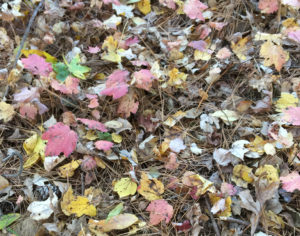 Newly fallen leaves make patterns on forest floor.
Newly fallen leaves make patterns on forest floor. So, what is going on at this mysterious sounding “O Horizon,” and why is it important for birds, pollinators and other wildlife? I can’t improve on the way it is stated by Rick Darke and Doug Tallamy in their book, The Living Landscape. They report that, “the ground layer and its intricate living processes are often overlooked in gardening circles, yet the events that occur here are among the most important to life in the entire ecosystem. The forest floor is where accumulated organic material [leaf and plant litter] is decomposed and made available once again for plant nutrition by a myriad of fungi and bacteria, earthworms, insects and other arthropods, and mammals.”
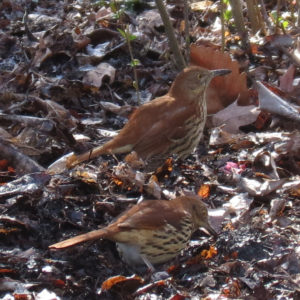 Brown Thrashers looking for food in leaf litter.
Brown Thrashers looking for food in leaf litter. Obviously, plants are very dependent on the health of the ground layer as, in turn, is the wildlife that feeds on the nectar, fruits, and leaves of these plants. Some wildlife, including many birds, feed directly at the ground layer and depend on it for habitat. The Ovenbird, for instance, is a ground layer specialist building its oven shaped nest at ground level from leaves; foraging in the leaf litter for arthropods; and evolving protective coloration that makes it hard to spot against the background of leaf litter. Ovenbirds spend their lives at ground level only popping up onto bushes to sing their mating songs. And there are many other examples. For instance, most of us have seen our resident Eastern Towhees and Brown Thrashers scratching in the leaves to find their food.
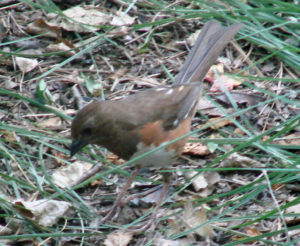 Female Eastern Towhee feeding in leaf litter.
Female Eastern Towhee feeding in leaf litter. When we do a site visit as part of the Bird Friendly Habitat Certification program, we list all the native and invasive plants we find, and in addition, also assess the health of the ground layer. We list a category on the form we fill out as, “Natural Ground Layer (leaves and other decaying organic matter),” and under that category, describe what we observe and then estimate the percent of natural coverage. So along with encouraging use of native plants at all layers of the landscape and removing invasive plants, we also stress to the property owner the importance of keeping and restoring a natural ground layer.
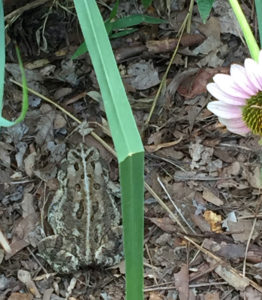 Toad blends in perfectly with leaf litter.
Toad blends in perfectly with leaf litter. Here are some recommendations on how you can improve the ground layer in your garden:
- Wherever possible, let leaves stay where they fall.
- Use a mulching mower to grind up leaves in lawn areas. When the leaf fall is too heavy to be absorbed into the lawn, run the mulching mower over the leaves and then rake the nicely ground-up leaves into nearby plant beds.
- Reduce lawn area to the minimum needed for recreation and other uses. Then you won’t need to mow or rake as much!
- Use leaves as mulch in your plant beds. If the leaves are too coarse (e.g., large oak leaves), run over them with a mower first or compost them.
- If you don’t have enough leaves, borrow from your neighbors who want to get rid of theirs!
- Purchasing pine bark nuggets or shredded pine bark for mulch will not confer nearly the same benefit as using leaves. Although these are “natural”, they aren’t something “naturally” found covering the entire ground layer in a forest, and bark and wood chips do not provide the nutritional value of leaves.
- Try not to use the shredded wood chips from tree removal in your plant beds without composting them first since they will take nitrogen from the soil as they decompose. Again, even though wood chips are natural, they will not confer the same nutritional value to the ground layer as leaves will.
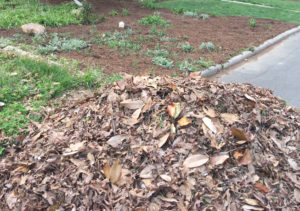 All the good leaf litter raked from yard!
All the good leaf litter raked from yard! You will find that mulching with leaves eliminates the need for fertilizer and reduces the need for watering. I’ve used only leaf mulch for years in my beds of native plants and have had no need for other fertilizers. Although I am somewhat disheartened every fall to see the piles of leaves raked to the street in my neighborhood, I am partly consoled by knowing that some of these leaves will soon be mine. I have the Town of Chapel Hill dump a load or two of leaves on my property each fall as they collect leaves in the neighborhood. This service is free of charge and gives me some great mulch.
So, I hope that you’ll have fun this fall “littering with leaves” and help our native plants, birds and other wildlife to thrive.
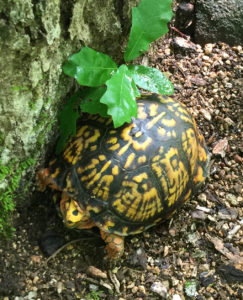 Eastern Box Turtle depends on ground layer.
Eastern Box Turtle depends on ground layer.Observed on one of our site visits.
Please see other sections of our website for more information on all aspects of using native plants and our certification program. This article has been the third in a series on restoring native habitat, so you may also want to look at “Going Native” and “To Every Plant There is a Season”, my two earlier articles. And be sure to read the Xerces Society’s new article, “Leave the Leafs!”
“Autumn is a second spring
when every leaf is a flower”
-Albert Camus